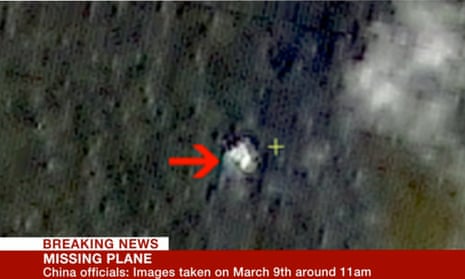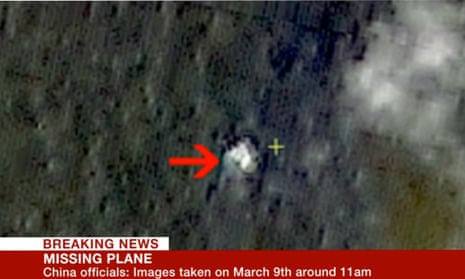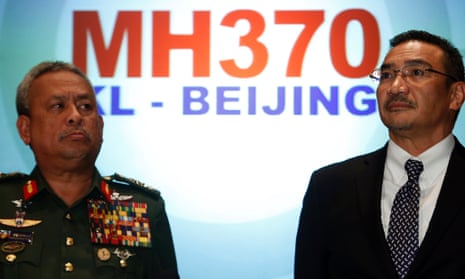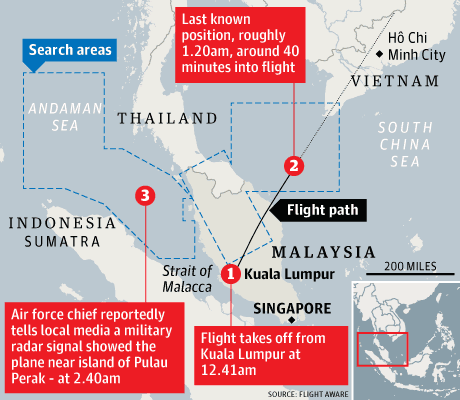Continuing coverage
This blog has ended. To follow our continuing coverage of the search for flight MH370, please go to our new live page here.

This blog has ended. To follow our continuing coverage of the search for flight MH370, please go to our new live page here.
A Chinese government agency has published satellite pictures that show “three suspected floating objects” in the South China Sea. The images were published by the Chinese State Administration for Science, Technology and Industry for National Defence (SASTIND), and dated 11am on Sunday, March 9.
The images were published on Wednesday evening local time in Beijing, some 10 hours ago, but were not picked up by international media until the past few hours. China’s official news agency, Xinhua, says the objects measure 13m by 18m (43ft by 59ft), 14m by 19m and 24m by 22m. For context, the Boeing 777 is just under 64m long.
Publication of the images has raised the already-strained tensions between the Chinese and Malaysian authorities. Two thirds of the passengers on flight MH370 were from China, and the authorities in Beijing have made it clear that they have deep concerns about how the Malaysians have conducted the search. Malaysian civil aviation director general Abdul Rahman told CNN his agency had not seen the images as of 6am local time Thursday.
The story about the Chinese satellite images has been amplified by China’s official Xinhua news agency, which said on Wednesday that the images, from around 11am on Sunday, appear to show “three suspected floating objects” of varying sizes.
Two-thirds of the passengers on the Malaysia airlines flight were Chinese, and the authorities in China have repeatedly indicated exasperation with the Malaysian authorities over how the search has been conducted.
The search area has has encompassed 35,800 square miles (92,600 sq km) of southeast Asia, and expanded on Wednesday towards India.
The satellite images published by the BBC and CNN are raising some concern in Malaysia. As we mentioned earlier, they were first posted by the Chinese science and national defence agency’s website some hours ago, which would have given search aircraft adequate time to approach the area where the debris was spotted.
Malaysian Civil Aviation director general Abdul Rahman tells CNN his agency has not received or seen the satellite images (it's around 6 am)
— Ram Ramgopal (@RamCNN) March 12, 2014
Here are the dimensions of the Boeing 777-200 ER to provide a context for the size of debris spotted by the Chinese satellite earlier.
The Chinese agency that published the satellite pictures actually released them Wednesday night local time. In what appears to be something of a big miss, until CNN and the BBC reported the pictures in the past hour, they went pretty much un-noticed.
But the American arm of the Chinese-funded English-language broadcaster, CCTV, tweeted the pictures seven hours ago. The Twitter account of CCTV America, at the time of writing, has 8,226 followers.
Image from Chinese satellite on 9th shows an object in the possible site of MH370. Verification is in progress. pic.twitter.com/Ag1FExZLUz
— CCTV America (@CCTV_America) March 12, 2014
Images from Chinese satellite on 9th shows three objects in the possible site of MH370. Verification is in progress. pic.twitter.com/AQzdLdfiI6
— CCTV America (@CCTV_America) March 12, 2014
CNN has posted more on the China satellite images, including co-ordinates.
China’s State Administration for Science, Technology and Industry for National Defense announced the discovery, including images of what it said were “three suspected floating objects and their sizes.” The objects aren’t small at 13 by 18 meters (43 by 59 feet), 14 by 19 meters and 24 by 22 meters.
The images were captured on March 9 - which was the day after the plane went missing - but weren’t released until Wednesday.
The Chinese agency gave coordinates of 105.63 east longitude, 6.7 north latitude, which would put it in waters northeast of where it took off in Kuala Lumpur, Malaysia, and south of Vietnam.
Boeing has confirmed that it issued a safety alert in June last year for Boeing 777s, telling airlines to check for cracks in the fuselage around a satellite antenna. The FAA in the US has issued a directive for repairs to be carried out. Boeing says the 777-200ER Malaysia Airlines aircraft did not have that antenna installed and was not subject to the FAA order.
The Associated Press has the text of the alert:
Cracks in the fuselage skin that are not found and repaired can propagate to the point where the fuselage skin structure cannot sustain limit load. When the fuselage skin cannot sustain limit load, this can result in possible rapid decompression and loss of structural integrity.
According to Reuters, it would not have affected the Malaysia jet.
Boeing said it worked closely with the FAA to monitor the fleet for potential safety issues and take appropriate actions. But it said the 777-200ER Malaysia Airlines aircraft did not have that antenna installed and was not subject to the FAA order.
The revelation of the Chinese satellite pictures is the latest in a series of contradictory developments. And until they are corroborated by investigators either flying over the area or at sea, they should be treated with caution. But if confirmed, the wreckage would put the crash site not far from the last confirmed radar contact with the plane, and contradicts suggestions that it might have turned back towards Malaysia and even made it back over the Strait of Malacca.
It also ties in with an earlier claim from an oil rig worker who claimed he saw a plane on fire over the South China Sea, southeast of Vietnam.
Meanwhile it was revealed that the last message from the cockpit of the missing Malaysia Airlines flight was routine. “All right, good night,” was the signoff transmitted to air traffic controllers five days ago. Then the Boeing 777 vanished.
CNN has broadcast more details of the Chinese satellite images. It said they were published by the Chinese State Administration for Science, Technology and Industry for National Defense (SASTIND), and dated March 9. They show a suspected crash site in the South China Sea, not far off the plane’s projected flight path. They show three large pieces at sea, the largest of which, according to SASTIND, measured 24m by 27m.
The BBC has just broadcast this satellite image which Chinese officials believe could be wreckage from Flight MH370.

In addition to the thousands of naval and aviation personnel, millions of people on the internet are crunching data in the search for MH370.
2 million+ Still Crowdsourcing for Clues on Missing Plane http://t.co/krx28IKEi4 @ABC #MH370
— Clayton Sandell (@Clayton_Sandell) March 12, 2014
The New Zealand Herald quotes a letter from an oil rig worker who claims he saw the missing Malaysian airlines flight go down in the sea southeast of Vietnam. The letter has been authenticated, the paper says.
Mike McKay told his employers, in an email made public overnight, that he had observed the plane burning at high altitude.
“I believe I saw the Malaysian Airlines plane come down. The timing is right,” he said.
“I tried to contact the Malaysian and Vietnam officials several days ago. But I do not know if the message has been received.”
Mr McKay said he was on the oil rig Songa Mercur, off south east Vietnam.
When he observed the plane it appeared to be in one piece, he said.
“From when I first saw the burning (plane) until the flames went out (still at high altitude) was 10 to 15 seconds,” he wrote.
Star Online has a clip of Malaysia’s air force chief Tan Sir Rodzali Daud giving the last possible radar signal from MH370 as happening at 2.15am last Saturday, 200 miles north west of Penang.
He did not sound very sure. Daud said: “I’m not saying this is MH370. We are still corroborating this ... There is a possibility of the aircraft making a come back. It remains as a possibility ... It is very difficult to say for sure it is the aircraft.”
The Straits Times has more on Vietnam’s decision to resume a full scale search, after announcing it was scaling back operations.
It could even ramp up the search on Thursday, Vietnamese navy deputy commander Le Minh Thanh said on Wednesday evening.
The flip flop was a result of reports that the plane was detected by Malaysian military radar over the Strait of Malacca, away from South China Sea waters off southern Vietnam being scoured by its ships and helicopters.
It caused Vietnamese deputy minister of transport Pham Quy Tieu to announce on Wednesday morning a temporary suspension of most search activities.
That evening though, Rear Admiral Thanh told reporters that the Vietnamese government still had not received any direct confirmation from Kuala Lumpur, but was resuming its search because of news that Malaysian authorities had denied reports about MH370’s Malacca Strait course.
“We will continue our search tomorrow, like we did today,” he told a room packed with reporters at an airport in the south Vietnamese island of Phu Quoc.

Here’s a summary of the latest developments:
During today’s press conference Malaysia armed forces chief Zulkifeli Mohd Zin admitted that he was “baffled” by why the missing plane sent no distress signal.
He also confirmed that the military were not tracking the plane in real time. He said:
When we looked back at the recording. It proved there is a possibility that this aircraft made a turn back. But we are not sure if it is the same aircraft.
We did not track it in real time.
Zin said the raw data would be released once it had been corroborated.

Vietnam, which had said it was scaling back its search efforts, has said it will resume a full scale operation on Thursday. A reporter for the Straits Times said it may even expand the operation.

During the press conference Malaysia Airlines was asked whether it was aware of a warning by the US officials about potential cracking that could compromise the safety of the Boeing 777.
In November the Federal Aviation Administration warned airlines to look out for corrosion under the skin of the fuselage.
The Daily Telegraph reported it warning:
We received a report of cracking and corrosion in the fuselage skin underneath the SATCOM antenna adapter . During a maintenance planning data inspection, one operator reported a 16-inch crack under the 3-bay SATCOM antenna adapter plate in the crown skin of the fuselage on an aeroplane that was 14 years old with approximately 14,000 total flight cycles.
Rahman was asked whether he had full confidence in the structural integrity of the missing Boeing 777 aircraft. He said: “From our records the aircraft when its flying is airworthy. It complies to all the directives.”
He confirmed that Malaysia had received the warning from the FAA about the Boeing’s fuselage.
Malaysia Airlines chief executive Ahmad Jauhari Yahyain added: “We ensure that all our aircraft are airworthy and comply with all the [circulars] issued by the manufacturers.”
He said he would check whether the missing plane was inspected for the known fault.
The most confusing and heated part of the press conference concerned the last known sighting of the aircraft. Hussein confirmed that it was last picked up by military rather than civilian radar.
The authorities initially stated that the plane lost contact with air traffic control at 1.20am, 40 minutes after take off from Kuala Lumpa.
On Tuesday air force chief Tan Sir Rodzali Daud wasd reported as saying the plane was later detected at 2.40am over the Malacca Strait. He has since denied saying this.
Today a military chief said the flight was last picked up at 2.15am local time.
Civil aviation chief Rahman said analysis of the defence radar showed an “indication of an air come back, hence that’s the reason why a search was conducted in Malacca and the Andaman Sea.”
An official gave the position of the last radar signal at 2.15am as 200 miles north west of the mainland. But he said this needed to be corroborated.
Hussein pointed out that this was not a definite contact with the missing plane. “The primary data does not tell you about the aricraft per se. It requires corroboration and detailed analysis by experts.”
Challenged on the conflicted data, he added: “It is only confusing if you want it to be seen to be confusion. We have been very consistent.”
Hussein was particularly defensive in the face of often hostile questioning from the press.
He said: “Unless we get the aircraft and the black box it is unlikely that we will be able to answer a lot of speculative issues that have been raised out there.
“We are focusing both on the South China Sea and the on the Straits of Malacca.”
Challenged about the criticism of the information released by the authorities, he said: “This is unprecedented what we are going through – coordinating so many countries together is not something that is easy. We are looking at so many vessels, so many countries to coordinate and a vast area for us to search ... but we will never give up hope.”
Here’s more from Transport Minister Hussein’s opening statement to the press conference:
We will not spare any effort to find the missing plane. The search has been extended to two areas and we are now searching nearly 27,000 square nautical miles – 12,425 square nautical miles in the Straits of Malacca and 14,440 square nautical miles in the South China Sea. Forty two ships and 39 aircraft have now been deployed in the search for MH370. Twelve countries have now joined the search, with India, Japan and Brunei being the latest to join the team.
The way forward is to bring more experts to analyses both the civilian and the military data, in the east or in the west, on land or in the water. This is exactly what we are doing. We are now working with many experts including from Boeing, the US Federal Aviation Authority and the US National Transport Safety Board.

Tania Branigan identifies a key nugget from the press conference that adds to the confusion. She reckons there are now three last possible recordings of the Boeing’s whereabouts.
What we have learnt: totally different third possible last record of plane. & transport min appears to have had media training in last 24h
— tania branigan (@taniabranigan) March 12, 2014
The press conference has come to end. It was an uncomfortable encounter for the increasingly defensive Malaysia officials, and short on new information.
Press conference on #MH370 ends. Search continues. No definite finds yet, say Malaysia officials pic.twitter.com/UKwOKXc91h
— ST Foreign Desk (@STForeignDesk) March 12, 2014
Britain’s engine manufacturer Rolls Royce has offered technical help, an official confirmed.
civil aviation chief: Aircraft investigation board of UK & Rolls Royce have offered to help [re reported data bursts from RR engines]
— tania branigan (@taniabranigan) March 12, 2014
The New Scientist revealed Rolls Royce may have received two sets of flight data from the missing plane. The first was at take-off and the second was during the climb towards Beijing. The data is from the Airborne Communications Addressing and Reporting System (ACARS):
The missing Malaysia Airlines jet sent at least two bursts of technical data back to the airline before it disappeared, New Scientist has learned. The data may help investigators understand what went wrong with the aircraft, no trace of which has yet been found.
To aid maintenance, most airlines use the Aircraft Communications Addressing and Reporting System (ACARS), which automatically collates and files four technical reports during every flight so that engineers can spot problems. These reports are sent via VHF radio or satellite at take-off, during the climb, at some point while cruising, and on landing.
Malaysia Airlines has not revealed if it has learned anything from ACARS data, or if it has any. Its eleventh media statement since the plane disappeared said: “All Malaysia Airlines aircraft are equipped with… ACARS which transmits data automatically. Nevertheless, there were no distress calls and no information was relayed.”
This would suggest no concrete data is to hand. But New Scientistunderstands that the maker of the missing Boeing 777’s Trent 800 engines, Rolls Royce, received two data reports from flight MH370 at its global engine health monitoring centre in Derby, UK, where it keeps real-time tabs on its engines in use. One was broadcast as MH370 took off from Kuala Lumpur International Airport, the other during the 777’s climb out towards Beijing.
A military chief admitted they were “baffled” by the lack of a distress signal from the aircraft. He confirmed that the military was “not sure” whether the plane had changed course.
“It is a possibility ... we did not track it in real time. The data appears [to suggest it changed course] we have to respond,” the official said.
He added that the raw data would be released in due course.
I think they just admitted no one was watching their military radar, only saw blip when they checked records afterwards MH370
— malcolmmoore (@MalcolmMoore) March 12, 2014
Hussein was asked why it had taken so long to reveal that the plane had turned back. He said the authorities were still not sure whether the plane had turned back which is why the search continues on both sides of the peninsula. “We have nothing to hide,” he said.
Hussein rejected criticised that the information issued had been “chaotic” or lack transparency. He pointed out that the information was changing.
Asked whether they were satisfied with the safety of the Boeing 777, Rahman stressed that the plane had passed a safety inspection.
“All our planes are airworthy”, an official added. Pressed on whether the authorities were aware of a known fault with the Boeing the official said he would have to check.
An aviation chief gave the coordinates for the last known radar sighting of the missing plane.
Military: 2.15am plot was 200 miles NW of Penang - cannot guarantee was MH370 - unidentified
— tania branigan (@taniabranigan) March 12, 2014
Civil aviation chief Azharuddin Abdul Rahman confirmed that defence radar picked up an “indication” that the plane turned back. He said this was why the search operation had been extended to the Andaman sea.
Hussein stressed this was just a “possibility”.
Hussein insisted that the authorities have been “consistent”.
He added: “We have not found anything but we are expanding it further.”
Hussein refused to be drawn on whether the plane changed course. “The family members are the ones I feel for so much,” he said.
Asked about the lack of transparency. “China obviously feels aggrieved because so many of their nationals are involved ... it will not changes our focus.”
Hussein did confirm that last sighting of the plane was picked up by the military.
In his brief statement Hussein said: “We will spare no effort to find the missing plane.”
He revealed that 27,000 square nautical miles are now being search.
Hussein said he could not answer speculative questions until the plane’s black box has been found.
The press conference is finally under way.
Malaysia’s defence and acting transport minister Hishammuddin Hussein confirms the search has been extended to two areas in the Straits of Malacca and the South China Sea.
Twelve countries are now involved in the search, he said.
Hussien said the “way forward” is to involve more military experts. Lots of military top brass are attending the conference.
“Embarrassment and anger” are mounting in Malaysia at the confusing and contradictory information issued by the authorities, according to the Malaysia Insider. In an opinion piece it said:
Do we have to wait and wonder for more than 24 hours the reasons for the expanded search at the Sumatra coast and the Andaman Sea because [Civil Aviation Chief] Azharuddin could only say cryptically: “There are some things that I can tell you and some things that I can’t.”
More importantly, will any of this delay make it even harder to find the 239 people onboard flight MH370 which has been missing for more than 100 hours now?
The whole world is watching Malaysia now because an aircraft with a wingspan of 61m does not fall off the sky or disappear into thin air just like that.
Relatives and friends of the 227 passengers and 12 crew members are also watching every step taken by the authorities. Any wrong move will diminish their confidence and trust that Malaysians are serious about the search and rescue mission.
As it is, the Malaysians will have a hard time explaining to their counterparts how they finally figured that flight MH370 turned back and was tracked until 2.40am Saturday – the same time Malaysia Airlines first said the jet disappeared.
Right now, 239 lives are at stake until they can be found. And time is running out unless the Malaysians get their act together and follow Beijing’s advice of telling all they know about flight MH370.
China will be watching the press conference closely. Its ambassador Huang Huikang is in the front row according to the Straits Times.
Dr Huang Huikang, China's envoy to Malaysia, at press conf in KL by Malaysia officials on missing @plane #MH370 pic.twitter.com/8Y4gQNv7Oy
— ST Foreign Desk (@STForeignDesk) March 12, 2014
Among those waiting for press conf to start is Huang Huikang, PRC ambo in Malaysia. He's in front row. #MH370 http://t.co/qEct3kp1sh
— Tom Phillips (@tomphillipsin) March 12, 2014
A press conference by the Malaysian authorities on the latest on the search for the missing plane is due to get underway any moment in Kuala Lumpur. Those expected to appear included Malaysia’s defence and acting transport minister, Hishammuddin Hussein, and its civil aviation chief, Azharuddin Abdul Rahman.
India has confirmed that Malaysia has asked for its help as the search for the missing planes expands towards the west.
Ministry of External Affairs spokesman Syed Akbaruddin said India had appointed an official to liaise with the Malaysian authorities, according to AP.
“This is a new development,” Akbaruddin said, referring to the search extending to the Andaman Sea, north of the Strait of Malacca. “The two sides were working out what specifics they want, and what we can assist in.”
Chinese criticism of the Malaysian authorities appears to be getting more trenchant.
An opinion piece in the Global Times said conflicting statements issued by officials in Kuala Lumpur appeared to be “chaotic”, and asked whether Malaysia was “deliberately” concealing information. It urged the authorities to share more information with China.
China has sent two more warships to help in the search for the plane after announcing that area it was searching has been extended yet further. China has already deployed eight ships to the operation, according to an update by the state broadcaster China View.
Welcome to our continuing live coverage of the search for Malaysia Airlines flight MH370, which disappeared last Friday with 239 passengers on board.
As we wait for the Malaysian authorities to give another press conference, here’s a round up of the latest developments:
You can read Paul Farrell’s earlier live coverage of the missing plane here.

Comments (…)
Sign in or create your Guardian account to join the discussion